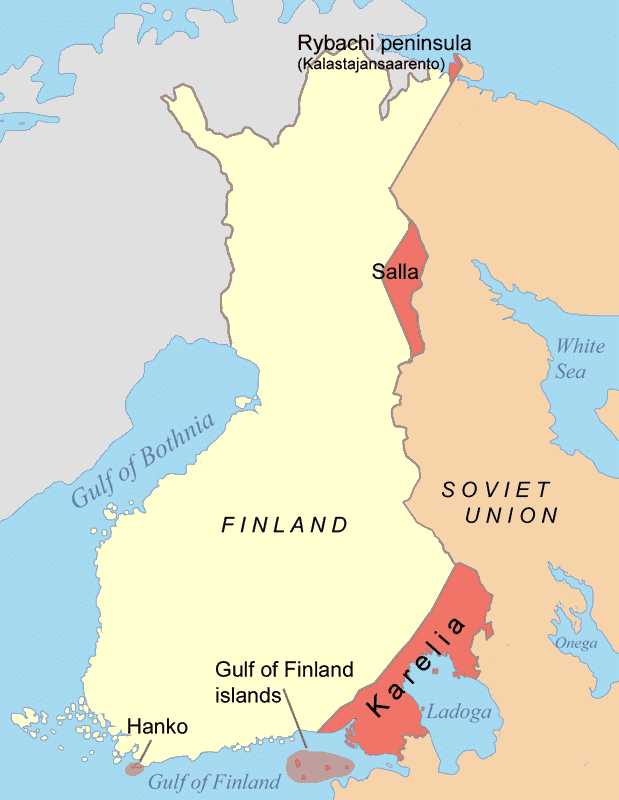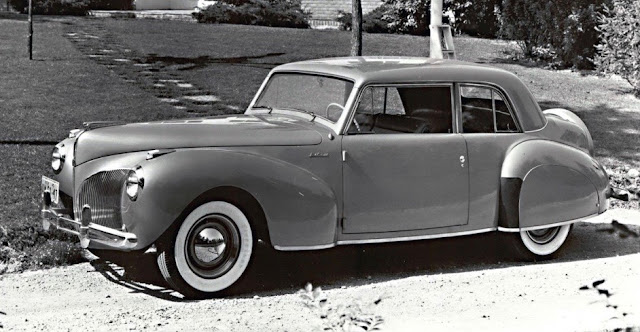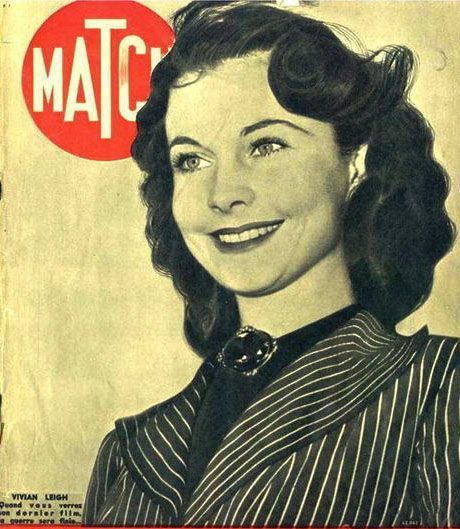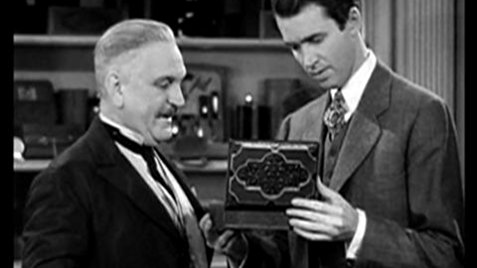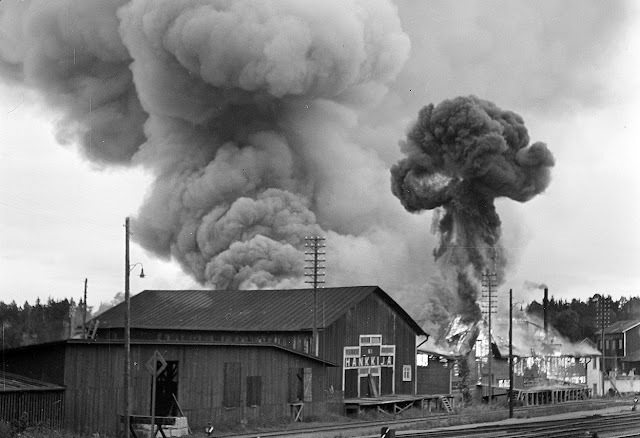Wednesday 20 March 1940
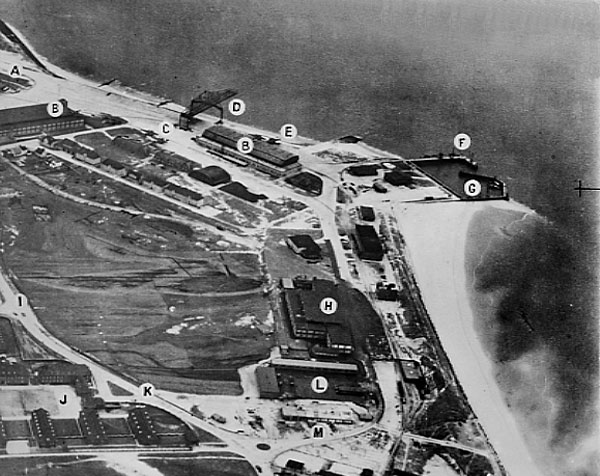 |
| A British reconnaissance photo of the German seaplane base on the Isle of Sylt with targets marked, 1940. |
Winter War: The Soviet Navy occupies its new base at Hango in Southern Finland.
Battle of the Atlantic: U-19 (Kapitänleutnant Joachim Schepke) continues its successful patrol on 20 March 1940 by torpedoing and sinking 1,153-ton Danish freighter Viking northeast of the Moray Firth at 05:00. Two crew survive, 15 perish.
Next, U-19 torpedoes and sinks the 2,109-ton Danish freighter Bothal at 05:15. Five of the crew survive, 15 perish.
The passenger liner Mauretania departs from New York with an unpublished destination.
The British respond to the Brazilian government's protest of the heavy cruiser HMS Dorsetshire's stopping of the German freighter Wakama on 12 February. They claim that they were only protecting Brazilian commerce. The Brazilians are not amused, as stated by the Brazilian Minister for Foreign Affairs Oswaldo Aranha:
U-22 (Karl-Heinrich Jenisch) is lost either today or sometime thereafter from unknown causes after leaving Wilhelmshaven. All 27 crew are presumed lost.
Convoy HG 23 departs from Gibraltar.
European Air Operations: Ten Luftwaffe bombers attack a coastal convoy of neutral ships. The RAF and Coastal Command defend the convoy. Three of the vessels are damaged: Norwegian Syinta and Topra Elise, and Swedish Utklippan. Several of the attacking planes are damaged.
RAF Coastal command sinks a Kriegsmarine ship, the converted freighter Altenfels now called German Sperrbrecher 12, while it is clearing mines.
The Luftwaffe attacks British freighter Barn Hill off the Isle of Wight. She has to be beached and later breaks in two.
An RAF attack overnight scores damage on the Sylt Island Luftwaffe seaplane base. RAF reconnaissance on Sylt shows damage to the hangers, jetty, oil tanks and other infrastructure. One RAF plane fails to return.
Western Front: The BEF claims that in an encounter with a German patrol, five Wehrmacht soldiers were killed.
German Propaganda: German radio claims of Allied shipping losses become a running joke throughout the war due to incidents such as this one: Dr. Goebbels claims today that a Luftwaffe attack on a British convoy sank 9 British ships totaling 42,000 tons. The British quickly respond on the BBC, noting that in fact no ships were sunk and only four damaged. They describe the German claims as "42,000 tons in excess of the actual facts."
French Government: The French cabinet resigns along with Daladier.
US Government: Undersecretary of State Sumner Welles ends his fact-finding tour of Europe and boards a liner at Genoa to return to the United States.
Soviet/Scandinavian Relations: Moscow expresses its displeasure at reports that the Scandinavian nations are going to form a mutual defense pact.
India: The Assembly of Congress Party calls for independence.
China: In the Battle of Wuyuan, the Chinese 35th Corps and associated units enter Wuyuan by surprise after dark. The two sides engage in fierce combat for control of the city throughout the night.
In the Battle of South Kwangsi, the Chinese East Route Force attacks the Japanese 22nd Army at the city the Japanese just captured, Lingshan.
Future History: US photojournalist Mary Ellen Mark is born. She shot stills for films such as Federico Fellini's "Satyricon" (1969) and Francis Ford Coppola's "Apocalypse Now" (1979). She passed away in 2015.
March 2, 1940: Soviets Swarm West in Finland
March 3, 1940: Soviets Across Gulf of Viipuri
March 4, 1940: USSR Apologizes to Sweden
March 5, 1940: Katyn Forest Massacre Approved
March 6, 1940: Finns Head to Moscow
March 7, 1940: The Coal Ships Affair
March 8, 1940: Peace Talks Begin in Moscow
March 9, 1940: Soviets Harden Peace Terms
March 10, 1940: Germany Draws Closer to Italy
March 11, 1940: Winter War Peace Terms Finalized
March 12, 1940: War is Over (If You Want It)
March 13, 1940: Winter War Ends
March 14, 1940: Evacuating Karelia
March 15, 1940: The Bletchley Bombe
March 16, 1940: First British Civilian Killed
March 17, 1940: Enter Dr. Todt
March 18, 1940: Mussolini To Join the War
March 19, 1940: Daladier Resigns
March 20, 1940: Soviets Occupy Hango Naval Base
March 21, 1940: Paul Reynaud Leads France
March 22, 1940: Night Fighters Arise!
March 24, 1940: French Consider Alternatives
March 25, 1940: Reynaud Proposes Action
March 26, 1940: C-46 First Flight
March 27, 1940: Himmler Authorizes Auschwitz Construction
March 28, 1940: Allies Ponder Invading Norway
March 29, 1940: Soviets Prefer Neutrality
March 30, 1940: Allied Uncertainty
March 31, 1940: The Tiger Cage
2019
Battle of the Atlantic: U-19 (Kapitänleutnant Joachim Schepke) continues its successful patrol on 20 March 1940 by torpedoing and sinking 1,153-ton Danish freighter Viking northeast of the Moray Firth at 05:00. Two crew survive, 15 perish.
Next, U-19 torpedoes and sinks the 2,109-ton Danish freighter Bothal at 05:15. Five of the crew survive, 15 perish.
The passenger liner Mauretania departs from New York with an unpublished destination.
The British respond to the Brazilian government's protest of the heavy cruiser HMS Dorsetshire's stopping of the German freighter Wakama on 12 February. They claim that they were only protecting Brazilian commerce. The Brazilians are not amused, as stated by the Brazilian Minister for Foreign Affairs Oswaldo Aranha:
Indeed you are not, you are definitely not protecting our commerce by maintaining your warships off our coast. It is apparent to me that your blockade of Germany is plainly ineffective. If it were effective, you could stop the German boats [sic] on the other side before they entered German ports.U-44 (Kptlt. Ludwig Mathes), if not sunk on 13 March 1940 by mine, is sunk today by destroyer depth charges. Either way, U-44 does not return from its mission, and all hands are presumed lost.
U-22 (Karl-Heinrich Jenisch) is lost either today or sometime thereafter from unknown causes after leaving Wilhelmshaven. All 27 crew are presumed lost.
Convoy HG 23 departs from Gibraltar.
European Air Operations: Ten Luftwaffe bombers attack a coastal convoy of neutral ships. The RAF and Coastal Command defend the convoy. Three of the vessels are damaged: Norwegian Syinta and Topra Elise, and Swedish Utklippan. Several of the attacking planes are damaged.
RAF Coastal command sinks a Kriegsmarine ship, the converted freighter Altenfels now called German Sperrbrecher 12, while it is clearing mines.
The Luftwaffe attacks British freighter Barn Hill off the Isle of Wight. She has to be beached and later breaks in two.
An RAF attack overnight scores damage on the Sylt Island Luftwaffe seaplane base. RAF reconnaissance on Sylt shows damage to the hangers, jetty, oil tanks and other infrastructure. One RAF plane fails to return.
Western Front: The BEF claims that in an encounter with a German patrol, five Wehrmacht soldiers were killed.
German Propaganda: German radio claims of Allied shipping losses become a running joke throughout the war due to incidents such as this one: Dr. Goebbels claims today that a Luftwaffe attack on a British convoy sank 9 British ships totaling 42,000 tons. The British quickly respond on the BBC, noting that in fact no ships were sunk and only four damaged. They describe the German claims as "42,000 tons in excess of the actual facts."
French Government: The French cabinet resigns along with Daladier.
US Government: Undersecretary of State Sumner Welles ends his fact-finding tour of Europe and boards a liner at Genoa to return to the United States.
Soviet/Scandinavian Relations: Moscow expresses its displeasure at reports that the Scandinavian nations are going to form a mutual defense pact.
India: The Assembly of Congress Party calls for independence.
China: In the Battle of Wuyuan, the Chinese 35th Corps and associated units enter Wuyuan by surprise after dark. The two sides engage in fierce combat for control of the city throughout the night.
In the Battle of South Kwangsi, the Chinese East Route Force attacks the Japanese 22nd Army at the city the Japanese just captured, Lingshan.
Future History: US photojournalist Mary Ellen Mark is born. She shot stills for films such as Federico Fellini's "Satyricon" (1969) and Francis Ford Coppola's "Apocalypse Now" (1979). She passed away in 2015.
 |
| Scripps Institute of Oceanography research vessel, E.W. Scripps (ship), aground on a sandbar until the next high tide came in. March 20, 1940. |
March 1940
March 1, 1940: Soviet Breakthroughs Past ViipuriMarch 2, 1940: Soviets Swarm West in Finland
March 3, 1940: Soviets Across Gulf of Viipuri
March 4, 1940: USSR Apologizes to Sweden
March 5, 1940: Katyn Forest Massacre Approved
March 6, 1940: Finns Head to Moscow
March 7, 1940: The Coal Ships Affair
March 8, 1940: Peace Talks Begin in Moscow
March 9, 1940: Soviets Harden Peace Terms
March 10, 1940: Germany Draws Closer to Italy
March 11, 1940: Winter War Peace Terms Finalized
March 12, 1940: War is Over (If You Want It)
March 13, 1940: Winter War Ends
March 14, 1940: Evacuating Karelia
March 15, 1940: The Bletchley Bombe
March 16, 1940: First British Civilian Killed
March 17, 1940: Enter Dr. Todt
March 18, 1940: Mussolini To Join the War
March 19, 1940: Daladier Resigns
March 20, 1940: Soviets Occupy Hango Naval Base
March 21, 1940: Paul Reynaud Leads France
March 22, 1940: Night Fighters Arise!
March 24, 1940: French Consider Alternatives
March 25, 1940: Reynaud Proposes Action
March 26, 1940: C-46 First Flight
March 27, 1940: Himmler Authorizes Auschwitz Construction
March 28, 1940: Allies Ponder Invading Norway
March 29, 1940: Soviets Prefer Neutrality
March 30, 1940: Allied Uncertainty
March 31, 1940: The Tiger Cage
2019
